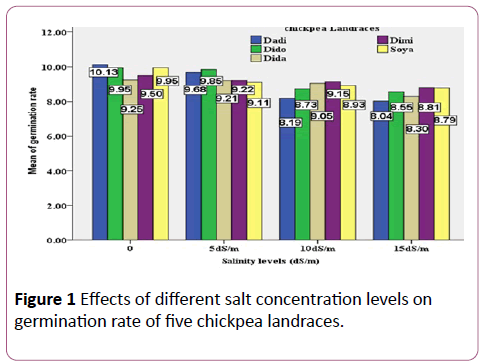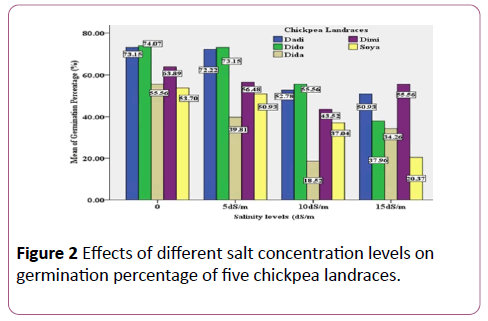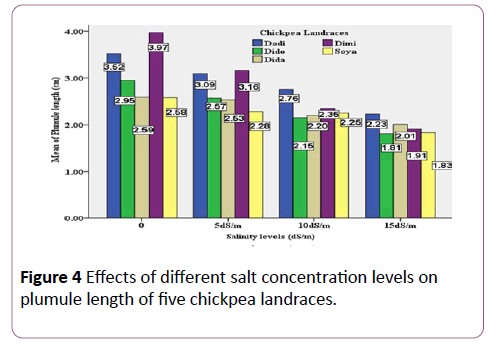Keywords
Chickpea; Landrace; Germination; NaCl; Salinity
Introduction
Chickpea (Cicer arietinum L.) is an important pulse crop and has high adaptability to a wide climatic condition as a food grain [1]. Globally, chickpea (Cicer arietinum L.) is ranked as a second important legume crop after dry beans [2]. It is grown in 54 countries with nearly 90% of its area covered in developing countries. Chickpea seed is a protein-rich supplement to cereal-based diets, especially critical in developing countries where people either cannot afford animal protein or vegetarian by choice [3]. It plays an important role in maintenance of the soil fertility through nitrogen fixation, particularly in the arid and low rainfall areas [1]. In Ethiopia, Chickpea seed can be eaten as green vegetable (eshet), roasted (kollo), boiled (nifro) and dry vegetable. Despite this fact, the yield of chickpea in Ethiopia is still low which can be accredited to biotic and abiotic factors [4].
However, crop production and productivity is seriously affected by abiotic factors throughout the world. During plant growth, they are usually exposed to different environmental stresses which limit their morphological growth. Soil salinity is one of the most serious problem which limits the productivity of agricultural crops with adverse effects on germination, crop vigour and crop yield [5]. Seed germination is one of the critical stage at which most of crop plants show their inhibition symptoms by salt. Certain crop plants are preserved from abiotic factors which inhibit them by developing their own different defense mechanism at this stage. The response of crop plant species to soil salinity problem depends on the genotypes, salt concentration, soil type and plant growing stage [6]. As other many pulses, chickpea is a salt sensitive pulse crop and its yield is seriously affected mainly by chloride salts [7]. The effect of soil salinity on chickpea is wide ranging and mainly chickpea is affected at germination and early stage [8].
Selection of tolerant genotypes would be an appropriate strategy to alleviate the adverse effect of salt at germination stage [9]. Soil salinity tolerance can be usually assessed as the percentage of biomass production in saline soil versus control conditions over a prolonged period of time or in terms of survival, which is quite appropriate for annual crop plant species [10]. Therefore, reclaiming salt affected land is always costive and requires long period of time [11]. In countries, like Ethiopia where legumes are principally grown for human consumption; the attention should remain on the development of salt tolerant varieties to attain food security of the rapidly growing population. The current study was aimed to screen out chickpea landraces responses to different salt concentration levels.
Materials and Methods
Description of study area
The research was carried out at Bule Hora University in the Biology laboratory in May 2016. It is far apart 467 km from Addis Ababa, Borena zone, Oromia Regional State and its geographical location is between 38°14'0'' longitude and 05°38'0'' North latitude. Bule Hora has an altitude 900 to 2600 m.a.s.l and receives annual rain fall 600 to 1500 m. The temperature of this wereda is ranges 15°C to 35°C with hot to warm sub-humid climate condition [12]. Five chickpea (Cicer arietinum L.) landraces used in this experiment were collected from three districts (Bule Hora, Yabello and Dire). From three districts, three kebeles were selected from Bule Hora, one from Yabello and one from Dire purposively based on the production of chickpea landrace for several years on these areas.
Germination of chickpea landraces conditions
Chickpea seeds were sterilized with 3% Sodium Hypochloride (NaOCl) solution for 1 min at room temperature [13]. Seventy-two petri dishes were washed and sterilized in hot air oven at 70°C for 48 hrs [14] and Whatman no. 2 filter papers at 70°C for 24 hrs. The Petri dishes with 90 mm uniform distance were lined with Whatman No. 2 filter paper and nine seeds from each kebele in it were treated with 0 dS/m, 5 dS/m, 10 dS/ and 15 dS/m concentrations of NaCl in one litre of distilled water, respectively. The petri dishes were organized with a Completely Randomized Design (CRD) with three replications. The distilled water was added into petri dishes as control treatments. The Petri dishes were hermetically closed up with parafilm to avoid evaporation rate [15] and then carefully kept in a humidity chamber at a temperature of 25°C ± 1°C under 8 hr/day length. Germination was carried out in a germination chamber with 12 hrs photoperiod. Salt solution with the same amount was applied on each treatment by 2 days interval. The numbers of sprouted seeds were counted with two days interval up to 14th day from the start of this experiment and sprouted seeds started to count after 3 days of sowing and up to 14th day. The seeds were considered to have germinated when both the plumule and radicle have been emerged greater than 0.5 cm.
Data collection
Germination parameters: Data was collected from the following.
Germination percentage (GP):

Germination rate (GR): It was calculated as suggested Lemma [16]:

Where: Tn=number of seeds germinated at day 3, 6, 9, 12; N=days (3, 6, 9, 12)
Plumule length: Plumule length was recorded by measuring the length of stem of an embryo and expressed in cm seed-1.
Radicle length: The radicle length was measured from the point of first cotyledonary node to the tip of longest root and expressed in cm seed-1.
Statistical analysis
Data was analyzed by using SPSS package where two-way analysis of variance (ANOVA) was employed. Whenever treatment differences are significant, means of the treatments were separated by using the Least Significant Difference (LSD) at 0.05 test.
Results
Analysis of variance indicated that there were significant differences between salt concentration levels in this experiment.
The results of that various concentrations of NaCl had a significant effect on almost all quantified agronomic traits of chickpea landraces. A variance revealed that the interaction outcomes were significant for all examined traits (Table 1).
| Source of variance |
DF |
GR |
GP |
PL |
RAL |
SHL |
ROL |
SHFW |
ROFW |
SHDW |
RODW |
SSHR |
SRR |
| SL |
3 |
1.61* |
738.47** |
1.25** |
20.66** |
13.17** |
122.08** |
0.103** |
0.14** |
0.14** |
0.01** |
75.02ns |
1378.74** |
| Landrace |
4 |
0.54ns |
531.28** |
0.39** |
9.07** |
9.21** |
88.03** |
0.10** |
0.11** |
0.11** |
0.00** |
303.42** |
1761.72** |
| SL x Landrace |
12 |
0.36 |
59.31 |
0.07 |
1.46 |
1.34 |
18.85 |
0 |
0.01 |
0.01 |
0 |
51.75 |
244.83 |
| Error |
-- |
0.06 |
9.69 |
0.01 |
0.24 |
0.22 |
3.07 |
0 |
0 |
0 |
0 |
8.45 |
39.99 |
*ns, **non-significance, Significant at 5% and 1% probability levels, respectively GR: Germination Rate; GP: Germination Percentage; PL: Plumule; RAL: Radicle Length; SHL: Shoot Length; ROL: Root Length; SHFW: Shoot Fresh Weight; ROFW: Root Fresh Weight; SHDW: Shoot Dry Weight; RODW: Root Dry Weight; SSHR: Seedling Shoot Reduction; SRR: Seedling Root Reduction
Table 1: Analysis of variance on mean squares of measured traits of chickpea landraces under salinity stress.
Germination rate
Analysis of variance displays significant differences between chickpea landraces genotype, salt concentration levels and their interaction with germination rate traits. The current outcomes revealed that chickpea landraces Dadi followed by Dido and Soya gave significant germination rate than the other landraces in the control petridish. And also, chickpea landraces Dido, Dimi and Soya showed high germination rate than the other landraces in 5 dS/m, 10 dS/m and 15 dS/m of salt concentration treatments. At the highest salt concentration level (15 dS/m), Dimi, Soya and Dido showed significantly higher mean germination rates than the other landraces tested (Figure 1).

Figure 1: Effects of different salt concentration levels on germination rate of five chickpea landraces.
The lefts are intermediate in their response to salinity stress.
Germination percentage
Germination percentage was observed that in all chickpea landraces, there was a decline in germination percentage because of increment of salt concentration on each treatment and maximum germination percentage was delayed.
In this experiment, different chickpea landraces had different resistant ability to the salt concentration levels. From the chickpea landraces Dido had the uppermost germination percentage and there was no significant difference in Soya chickpea landrace (Figure 2).

Figure 2: Effects of different salt concentration levels on germination percentage of five chickpea landraces.
But, the maximum reduction in germination percentage was exhibited at the highest level of salt concentration i.e., 15 dS/m.
Radicle length
As results was clearly determined that, there were significant differences between studied landraces at 5 dS/m, 10 dS/m and 15 dS/m of salinity levels for the length of radicle. From the chickpea landraces, Dido and Dadi were scored the highest mean of radicle length at 5 dS/m (Figure 3).

Figure 3: Effects of different salt concentration levels on radicle length of five chickpea landraces.
Plumule length
Stem of an embryo plant height was recorded at early germination stage. This was recorded on 12th day after treatments and expressed in centimeter (cm). Therefore, the result indicates that the plumule length is decrease for all landraces at 15 dS/m salinity level (Figure 4).

Figure 4: Effects of different salt concentration levels on plumule length of five chickpea landraces.
Discussion
The main point of this study was to make out salt tolerant landraces in chickpea germplasm at germination stage under different salt concentration levels. The analysis of variance for chickpea landraces, salt concentration levels and their interaction was found to be significant for almost all parameters which reflect that all the chickpea landraces respond to different salt concentration levels with respect to all parameters.
Increment of salt concentration levels caused significant reduction in germination rate (GR) of chickpea landrace in medium. Yet, the reduction was identified at 5 dS/m, 10 dS/m and 15 dS/m salt concentration levels, respectively. On the basis of germination rate for the soils having 15 dS/m salt concentration, chickpea landraces Dimi can be recommended (Figure 1). The consequence of salt concentration problem on seed germination rate is associated with which has been reported in previous studies [17]. There are many reports which specify that the genotypes which were attained higher germination rate under soil saline conditions produced higher biomass and yield [18,19]. In addition, many results confirmed that increased salt concentration reduces germination rate [20]. Reduction in germination rate is due to toxic effects of salts that diminish the water potential in the medium which hinders water absorption by germinating seeds [21].
Higher salt concentration level impedes seed germination and radicle emergence due to osmotic effect which is deleterious and prevents the seeds from maintaining their healthy growth [19]. The maximum germination percentage was achieved at zero (0 dS/m) salt concentration level (Figure 2). The results of this experiment also decided with the results of previously studied [22]. And also, this experiment results are agreement with Rejili et al. [23] demonstrated decreasing in germination percentage that resulted due to osmotic effect of salt concentration present in the growth medium (soil).
Soil salinity causes reduction in radicle and plumule growth, which means increasing of salt concentration in soil, has adverse effect on radicle and plumule length. The presence of unexpected salt concentration in the growth medium can reduce the absorption of water due to lessening of the osmotic potential and affects cell division [24]. In this experiment, the length of plumule and radicle are negatively affected by salinity. According to [25], the length of plumule and radicle retardation is due to salinity effect and other reports also may be due to ionic toxicity, disturbance in nutrients uptake [26], osmotic effects of salinity [24], water absorption [27], resulting in reduction in biosynthesis of enzymes and plant hormones necessary for growth [28].
The soil salinity stress imposed crop seed at germination stage, by damaging cell membranes of the seed due to cell membrane permeability increases, replacing of Ca2+ with Na+ and leakage of K+ [29]. For this reason, the length of radicle provides an important clue to the response of crop plants to soil salinity problem. Among the chickpea landraces, Dadi had the highest length of radicle, while, soya had the lowest length of radicle at 15 dS/m salt concentration level (Figure 3).
Chickpea landraces Dadi and Dimi also had the highest length of plumule at 10 dS/m salt concentration level (Figure 4). Results of this study showed that length of radicle and plumule are decreased with increasing salt concentration level in all landraces. These results are in agreement with many researches [30,31].
Conclusion
Increment of NaCl has direct harmful effects on chickpea landrace seed germination. At the germination stage, chickpea was found to be sensitive at high level of salt concentration. In general, one of the most important strategies to overcome soil salinity problem are to screen out tolerant landraces morphologically and exploit high genetic variable of germplasm through breeding program which sustain a reasonable yield in salt affected soil areas.
Acknowledgement
Our gratitude and thanks to Agricultural office of Bule Hora, Yabelo and Dire districts for their unreserved help and assistance about chickpea landraces during seed collection from stakeholders. I would like to express our heartfelt thanks to Bule Hora University for its financial assistance and for providing the research site. We also especial thanks our families for giving immeasurable encouragement during our research work.
References
- Roy F, Boye J, Simpson B (2010) Bioactive proteins and peptides in pulse crops: Pea, chickpea and lentil. Food Res Int 43: 432-442.
- Varshney RK, Ribaut JM, Buckler ES, Tuberosa R, Rafalski JA, et al. (2013) Genomics boost productivity of orphan crops. Nat Biotechnol 30: 1172-1176.
- Gaur PM, Jukanti AK, Varshney RK (2012) Impact of genomic technologies on chickpea breeding strategies. J Agr 2: 199-221.
- Geletu B, Yadeta A (2002) Evaluation of Ethiopian chickpea landraces for tolerance to drought. Genetic Resources and Crop Evaluation 49: 557-564.
- Munns R, Tester M (2008) Mechanisms of salinity tolerance. Annu Rev Plant Biol 59: 651-681.
- Mauromicale G, Licandro P (2002) Salinity and temperature effects on germination, emergence and seedling growth of globe artichoke. Agronomy 22: 443-450.
- Manchanda HR, Sharma SK (1990) Influence of different chloride sulphate ratios on yield of chickpea (Cicer arietinum) at comparable salinity levels. Indian J Agric Sci 60: 553-555.
- Khan S, Iqbal J, Saeed M (2013) Comparative study of grain yield and biochemical traits of different rice varieties grown under saline and normal conditions. J Anim Plant Sci 23: 575-588.
- Hasegawa PM, Bressan RA, Zhu JK, Bohnert HJ (2000) Plant cellular and molecular responses to high salinity. Annu Rev Plant Physiol Plant Mol Biol 51: 463-499.
- Munns R (2002) Comparative physiology of salt and water stress. Plant Cell Environ 25: 239-250.
- Turan MA, Katkat V, Taban S (2007) Variations in proline, chlorophyll and mineral elements contents of wheat plants grown under salinity stress. Agro 6: 137-141.
- Bule Hora woreda Administration (2010) Statistical Agency, Ethiopia.
- Sauer DB, Burroughs R (1986) Disinfection of seed surfaces with sodiumhypochlorite. Phytopathol 76: 745-749.
- Muhammad Z, Hussain F (2010) Effect of NaCl salinity on the germination and seedling growth of some medicinal plants. Pak J Bot 42: 889-897.
- Asgharipour MR, Rafiei M (2011) Effect of salinity on germination and seedling growth of lentils. Austr J Basic Appl Sci 5: 2002-2004.
- Lemma D (1996) Salt tolerance in tomatoes (Lycopersicon esculentum Hill). A thesis submitted by lemma Deslegne for the Degree of Doctor of Philosophy. Department of Agricultural Botany, School of Plant Science, University of Reading, UK. pp: 245.
- Ashraf CM, Abu-Shakra S (1978) Maize seed germination under low temperature and moisture stress. J Agr 70: 135-139.
- Ashraf MY, Akhtar K, Hussain F Iqbal J (2006) Screening of different accession of three potential grass species from Cholistan desert for salt tolerance. Pak J Bot 38: 1589-1597.
- Krishnamurthy L, Serraj R, Hash AJ, Reddy BV (2007) Screening sorghum genotypes for salinity tolerant biomass production. J Euph 156: 15-24.







